Snakes are fascinating creatures that have been around for millions of years. They come in all shapes and sizes, from the tiny thread snake to the massive anaconda.
In this article, we will be exploring the top 10 biggest snakes in the world. These snakes are truly impressive in terms of their size and strength, and they have captured the imagination of people around the world.
You are reading: Top 10 Biggest Snakes In The World
From the green anaconda to the king brown snake, we will take a closer look at these amazing reptiles and learn more about their habitats, diets, and behaviors. So, let’s get started and discover the biggest snakes in the world!
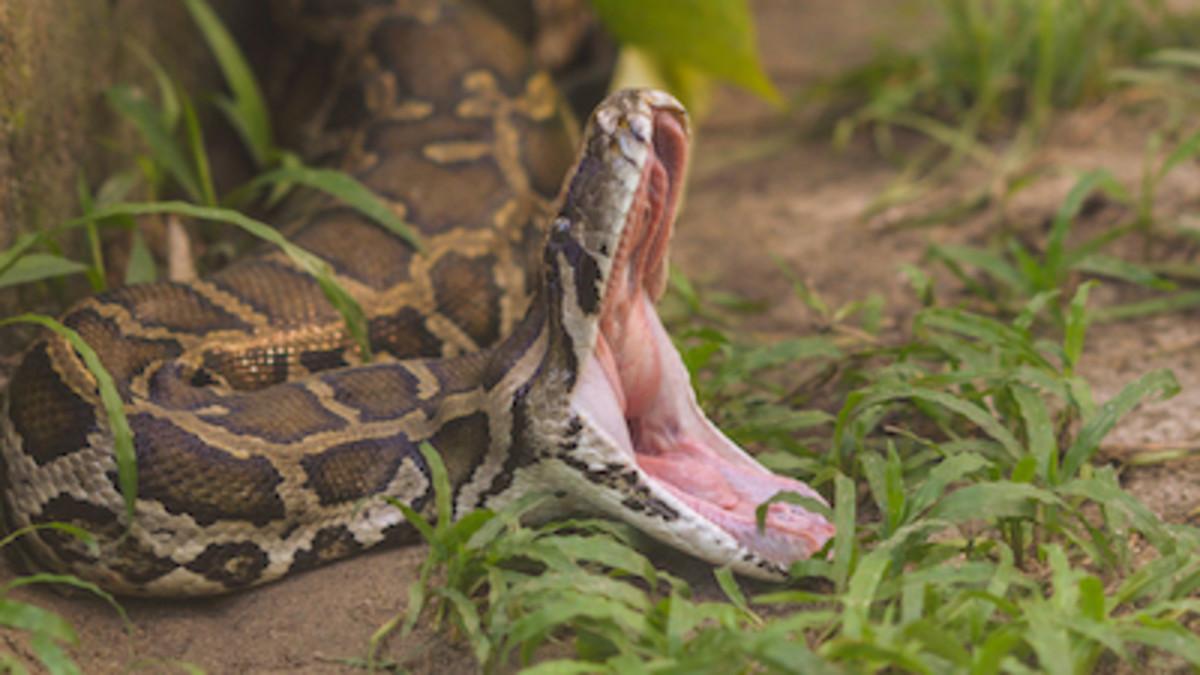
Top 10 Biggest Snakes In The World
Green Anaconda
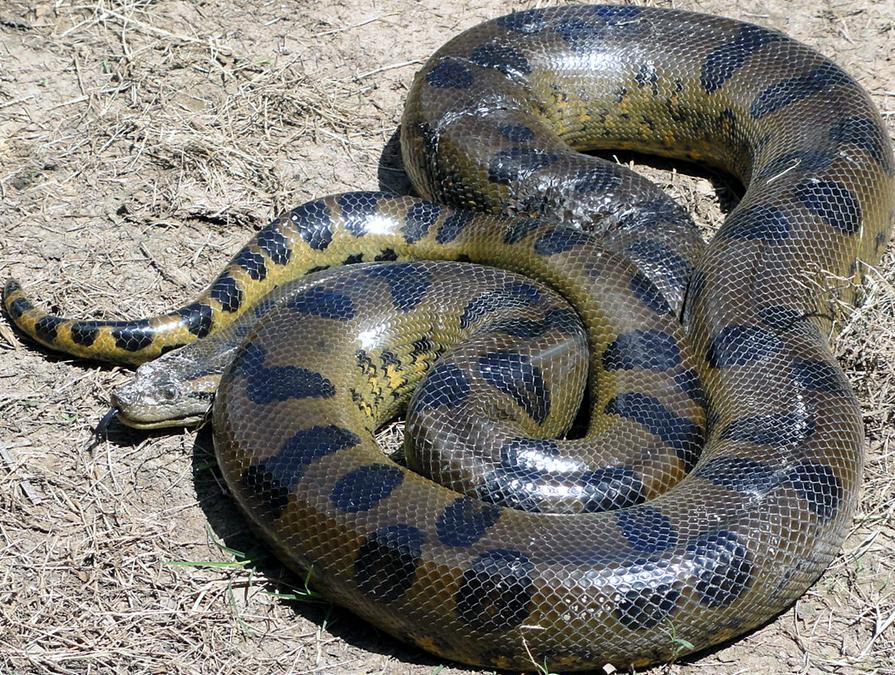
The green anaconda (Eunectes murinus) is the largest and one of the longest known extant snake species in the world. It is a non-venomous constrictor and a member of the Boidae family of snakes.
The green anaconda is also known as the giant emerald anaconda, common anaconda, common water boa, or sucuri. It is native to South America and the Caribbean island of Trinidad.
Green anacondas are olive-green with dark oval spots along their spines and similar spots with yellow centers along their sides. They can reach lengths of up to 30 feet (9 meters) and weigh up to 550 pounds.
Females are considerably larger than males. Green anacondas live in swamps, marshes, and slow-moving rivers or streams, and they are most abundant in the Orinoco basin in Columbia, the Amazon River basin in Brazil, and the flooded Llanos grasslands in Venezuela. They are also found in Ecuador, Peru, Bolivia, Guyana, Paraguay, French Guiana, and Trinidad.
Green anacondas are carnivores and feed on a variety of prey, including fish, caimans, capybaras, deer, tapirs, and peccaries.
Reticulated Python
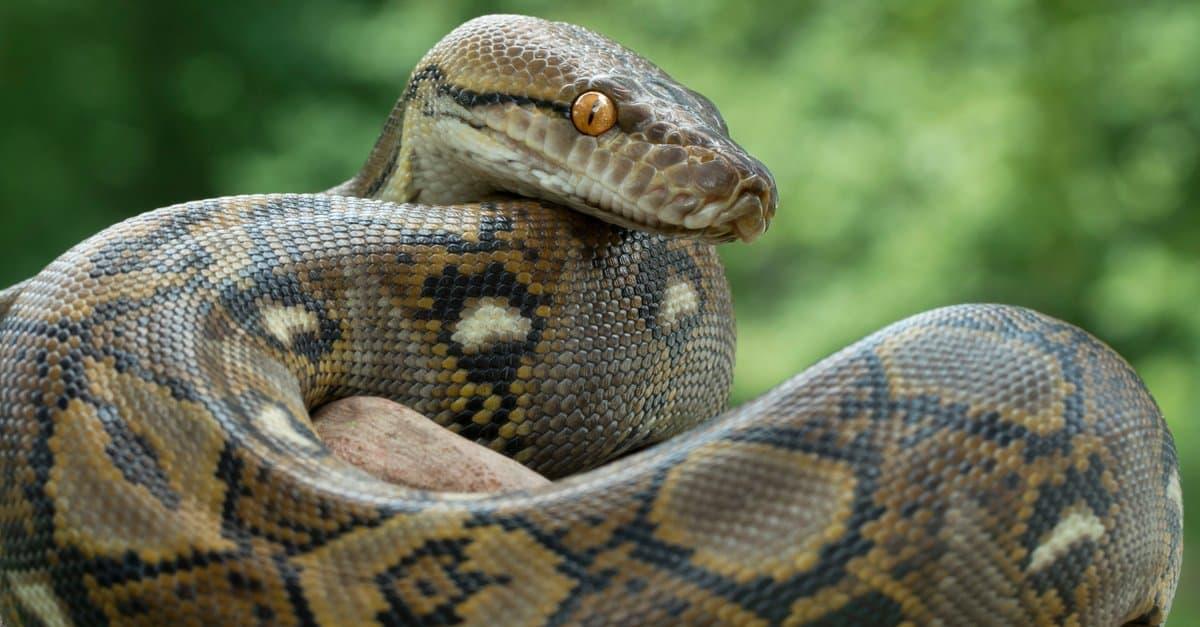
The reticulated python (Malayopython reticulatus) is a species of python native to South and Southeast Asia. It is the world’s longest snake and is among the three heaviest.
Reticulated pythons are members of the family Pythonidae, cousins to snakes like the Burmese python, ball python, and green tree python. They are also known as the Malayopython reticulatus.
Reticulated pythons are heavy-bodied, very long snakes with a proportionately large head. They are non-venomous constrictors and are listed as least concern on the IUCN Red List because of their wide distribution.
Reticulated pythons are popular pets, but they can get big enough to kill their owner. They are carnivores and feed on a variety of prey, including mammals and occasionally birds.
Reticulated pythons prefer a wet, tropical climate and usually inhabit areas adjacent to rivers, streams, or other water-bodies. They may also frequent cave areas, trees, or ground areas concealed in vegetation.
Amethystine Python
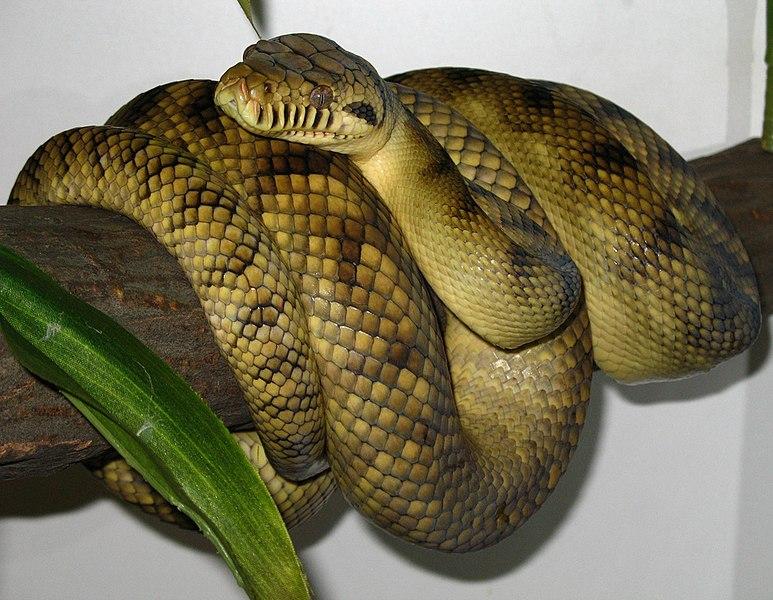
The amethystine python (Simalia amethistina), also known as the scrub python or sanca permata in Indonesian, is a species of non-venomous snake in the family Pythonidae.
– The species is found in Indonesia, Papua New Guinea, and Australia.
– It is one of the largest snakes in the world, as measured either by length or weight.
– The amethystine python is popular among reptile enthusiasts because of its coloration and size.
– It is a surprisingly thin species for its length, and most 12-foot-long snakes only weigh about 10-15 pounds.
– The head of the amethystine python is relatively small compared to its body.
– The amethystine python is a non-venomous constrictor and feeds on a variety of prey, including mammals and birds.
– The species prefers a tropical climate and usually inhabits areas adjacent to rivers, streams, or other water-bodies.
– The amethystine python is oviparous, meaning it lays eggs.
Overall, the amethystine python is an impressive snake that is known for its size and coloration. It is found in several countries in Southeast Asia and Australia and is a popular species among reptile enthusiasts.
Burmese Python
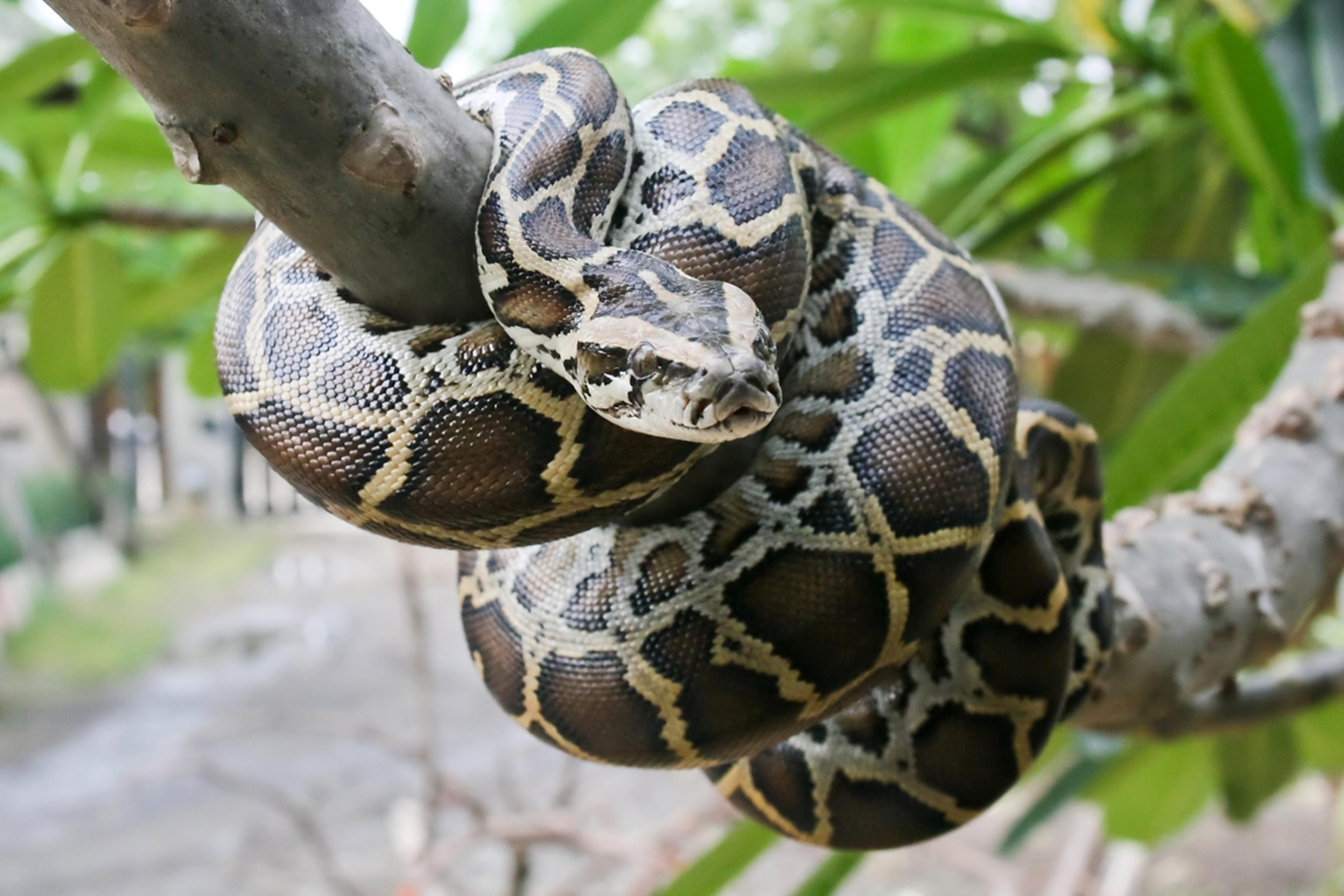
The Burmese python (Python bivittatus) is one of the largest species of snakes in the world, native to a large area of Southeast Asia and listed as Vulnerable on the IUCN Red List. Until 2009, it was considered a subspecies of the Indian python, but is now recognized as a distinct species.
Burmese pythons are dark-colored non-venomous snakes with many brown blotches bordered by black down the back. In the wild, they typically grow to 5 meters (16 feet), while specimens of more than 7 meters (23 feet) are unconfirmed. Females are considerably heavier and bulkier than males.
Burmese pythons are carnivores and eat mostly small mammals and birds, but exceptionally large pythons may search for larger food items like pigs or goats. They have even been known to have attacked and eaten alligators.
Burmese pythons are capable of reaching 23 feet or more in length and weighing up to 200 pounds with a girth as big as a telephone pole. They are sexually dimorphic in size, with females averaging only slightly longer than males.
Burmese pythons prefer a tropical climate and usually inhabit areas adjacent to rivers, streams, or other water-bodies. They are also an invasive species in Florida as a result of the pet trade and are found primarily in and around the Everglades ecosystem in south Florida where they represent a threat to native wildlife.
Indian Python
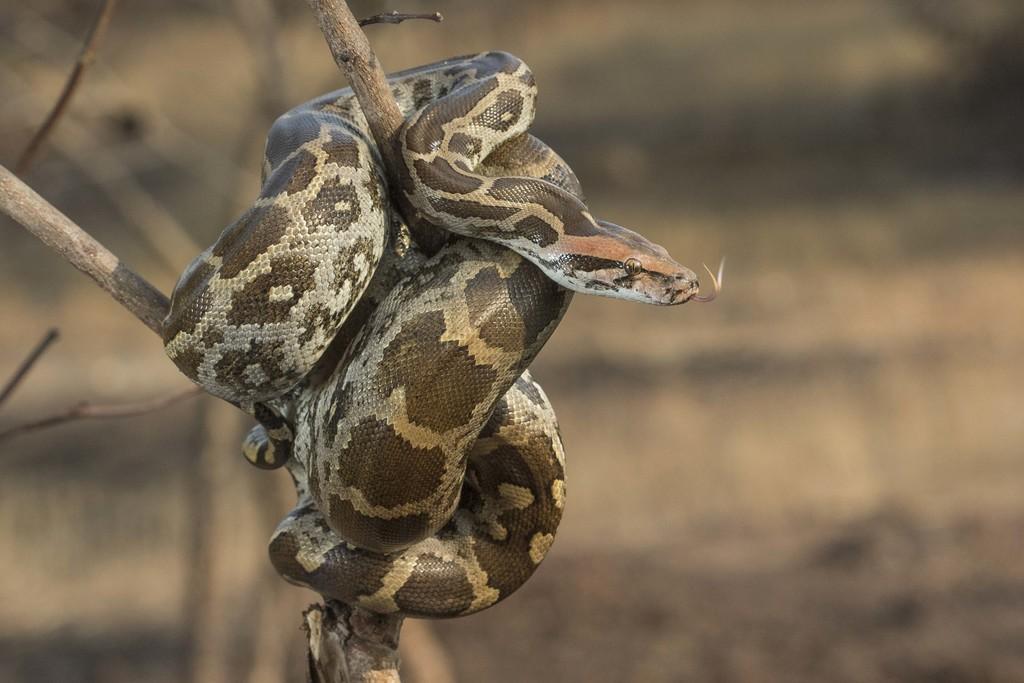
The Indian python (Python molurus) is a large nonvenomous python species native to tropical and subtropical regions of the Indian subcontinent and Southeast Asia.
– It is also known by the common names black-tailed python, Indian rock python, and Asian rock python.
– Although smaller than its close relative the Burmese python, it is still among the largest snakes in the world.
– It is generally lighter colored than the Burmese python and usually reaches a length of 3 meters (9 feet 10 inches).
– Like all pythons, it is a nonvenomous constrictor.
– Indian pythons are divided into two recognized subspecies, which can be distinguished by physical characteristics.
– Burmese pythons (Python bivittatus) were referred to as a subspecies of the Indian python until 2009, when they were elevated to full species status.
Read more : Top 10 Smallest Monkeys In The World
– Indian pythons are highly arboreal snakes and were once fairly common throughout the jungles of India, Sri Lanka, and the East Indies.
– They are carnivores and feed on a variety of prey, including rodents, birds, and mammals.
– Indian pythons are threatened by habitat loss, hunting for their skin and meat, and capture for the pet trade.
Overall, the Indian python is an impressive snake that is known for its size and beauty. It is found in several countries in Southeast Asia and is a popular species among reptile enthusiasts.
African Rock Python
The African rock python (Python sebae) is a large nonvenomous snake species native to sub-Saharan Africa.
– It is one of the largest species of snakes in the world, with some individuals reaching lengths of over 20 feet.
– African rock pythons have a relatively small, triangular head that is covered in irregular scales that are typically blackish to brownish-gray in color.
– The body of the African rock python is thick and covered with colored blotches, often joining up in a broad, irregular stripe.
– Body markings vary between brown, olive, chestnut, and yellow, but fade to white on the underside.
– The African rock python is highly dependent on water and often submerges itself near the banks of a stream and waits for prey.
– They are carnivores and feed on a variety of prey, including small rodents, birds, and larger animals such as antelope, warthogs, dogs, monkeys, waterfowl, goats, and even crocodiles.
– Females lay up to 100 eggs and defend them aggressively.
– The African rock python is still relatively common in many regions across Africa, but its population in West Africa has suffered greatly.
– African rock pythons are dormant during the dry season.
Overall, the African rock python is an impressive snake that is known for its size and strength. It is found in many countries in sub-Saharan Africa and is a fascinating species to study.
King Cobra
The king cobra (Ophiophagus hannah) is a venomous snake that is native to Asia.
Physical Characteristics:
– The king cobra is the world’s longest venomous snake, with an average length of 3.18 to 4 meters (10.4 to 13.1 feet) and a maximum record of 5.85 meters (19.2 feet) .
– It has a relatively small, triangular head that is covered in irregular scales that are typically blackish to brownish-gray in color.
– The body of the king cobra is thick and covered with colored blotches, often joining up in a broad, irregular stripe.
– Body markings vary between brown, olive, chestnut, and yellow, but fade to white on the underside.
– The throat is light yellow or cream-colored.
Habitat and Diet:
– King cobras live in northern India, east to southern China, including Hong Kong and Hainan; south throughout the Malay Peninsula and east to western Indonesia and the Philippines.
– They prefer streams in dense or open forest, bamboo thickets, adjacent agricultural areas, and dense mangrove swamps.
– They spend almost a fourth of their time up in trees or bushes.
– King cobras are carnivores and feed on a variety of prey, including other snakes and lizards.
– Their venom is not the most potent among venomous snakes, but the amount of neurotoxin they can deliver in a single bite is enough to kill an elephant.
Behavior:
– King cobras are regarded as fierce and aggressive snakes, and their length and size give them an awe-inspiring appearance.
– They are not normally aggressive to humans, but they are hostile and dangerous during the breeding season or when cornered or startled.
– When confronted, they can lift up to a third of their body off the ground and still move forward to attack.
– They will also flare out their iconic hood and emit a hiss that sounds almost like a growling dog.
Overall, the king cobra is an impressive and dangerous snake that is known for its size and venomous bite. It is found in several countries in Asia and is a fascinating species to study.
Boa Constrictor
The boa constrictor (Boa constrictor) is a large, non-venomous snake species that is found in Central and South America.
Physical Characteristics:
– Boa constrictors are powerful snakes with a thick, muscular body that can grow up to 13 feet long and weigh more than 100 pounds.
– Depending on the habitat that a boa constrictor occupies, its patterns and coloring vary to allow it to camouflage. The body can be tan, green, red, or yellow and will have cryptic patterns that form bars, jagged lines, diamonds, and circles.
– The head of the boa constrictor is relatively small compared to its body.
– Boa constrictors are named after their mode of predation: constriction. Instead of injecting poison into its prey, it strikes, grabs, and squeezes until the prey is subdued. Once the prey is dead, the snake swallows it whole.
Habitat and Diet:
Read more : Discover The Top 5 Most Expensive Spiders You Can Buy In 2023
– Boa constrictors are able to adjust their hunting behaviors according to the density of possible prey items in their habitat. In most cases, they are ambush predators, meaning they sit and wait for a desirable prey item to pass by. However, if food is scarce, they become more active to seek out prey.
– They feed on large lizards, small or moderate-sized birds, opossums, bats, mongooses, rats, and squirrels.
– Boa constrictors are hunted and collected for their skin.
Behavior:
– Boa constrictors are generally solitary animals and tend to live alone.
– Mother boas give birth to about 60 babies at a time, and the baby boas are on their own from the start. They are born with the instinct, or built-in knowledge, of how to hunt. It also has an instinct to hide to stay safe from predators. The baby boa’s diet changes as it grows. The bigger it gets, the bigger the prey it can eat.
Overall, the boa constrictor is an impressive snake that is known for its size and strength. It is found in several countries in Central and South America and is a fascinating species to study.
Black Mamba
The black mamba (Dendroaspis polylepis) is a highly venomous snake species belonging to the family Elapidae and is native to sub-Saharan Africa.
Physical Characteristics:
– The black mamba is the second-longest venomous snake after the king cobra, with mature specimens generally exceeding 2 meters (6 ft 7 in) and commonly growing to 3 meters (9.8 ft). Specimens of 4.3 to 4.5 meters (14 to 15 ft) have been reported.
– Its skin color varies from gray to dark brown, and it has a long, thin tail, with the caudal vertebrae making up 17–25% of its body length.
– The black mamba is a proteroglyphous (front-fanged) snake, with fangs up to 6.5 mm (0.26 in) in length, located at the front of the maxilla.
Habitat and Diet:
– Black mambas live in the savannas and rocky hills of southern and eastern Africa.
– They are carnivores and feed on small mammals, birds, and other snakes.
– Black mambas are among the fastest snakes in the world, slithering at speeds of up to 12.5 miles per hour.
Behavior:
– Black mambas are fast, nervous, and highly aggressive when threatened.
– They are widely considered the world’s deadliest snake because of their venom toxicity and speed of onset of symptoms following envenomation.
– The respiratory system is especially affected by a black mamba bite, and not all bites are fatal.
Overall, the black mamba is a dangerous and fascinating snake that is known for its speed and venomous bite. It is found in several countries in sub-Saharan Africa and is a species to be respected and avoided.
King Brown Snake
The king brown snake, also known as the mulga snake, is a highly venomous snake found over most of mainland Australia, except for the extreme south.
Physical Characteristics:
– The king brown snake is a robust snake that can grow up to 3.3 meters (11 feet) long.
– It has brown skin, a wide head, a smooth snout, and the largest eyes of any Australian snake.
– The scales on its back are smooth and glossy, while those on its belly are rougher.
Habitat and Diet:
– King brown snakes are found in a variety of habitats, including deserts, grasslands, and woodlands.
– They are generalist predators and feed on a variety of prey, including frogs, lizards, other snakes, birds, and small mammals such as rodents.
Behavior:
– King brown snakes are active during the day and are known for their aggressive behavior when threatened.
– They are also known for their ability to survive in harsh environments, such as the Australian outback.
Overall, the king brown snake is a dangerous and fascinating snake that is known for its venomous bite and robust size. It is found in several habitats across mainland Australia and is a species to be respected and avoided.
FAQS
1. What is the biggest snake in the world?
The biggest snake in the world is the green anaconda, which can reach lengths of up to 30 feet and weigh over 500 pounds.
2. What is the second-biggest snake in the world?
The reticulated python is the second-biggest snake in the world, with an average length of around 5-7 meters.
3. What is the deadliest snake in the world?
The black mamba is widely considered the world’s deadliest snake because of its venom toxicity and speed of onset of symptoms following envenomation.
4. Are all big snakes dangerous?
Not all big snakes are dangerous. Some big snakes, like the green anaconda, are non-venomous and pose no threat to humans unless provoked.
5. Where are the biggest snakes in the world found?
The biggest snakes in the world are found in various regions across the globe, including Southeast Asia, South America, and Africa.
6. What do the biggest snakes in the world eat?
The biggest snakes in the world are carnivores and feed on a variety of prey, including mammals, birds, and other snakes.
7. Can big snakes be kept as pets?
Some big snakes, like the reticulated python and the Burmese python, are popular pets. However, they can grow to be very large and require specialized care, so they are not suitable for everyone.
8. Are big snakes endangered?
Some big snake species, like the green anaconda and the Indian python, are listed as vulnerable or endangered due to habitat loss and hunting for their skin and meat.
Source: https://petstutorial.com
Category: Animals










